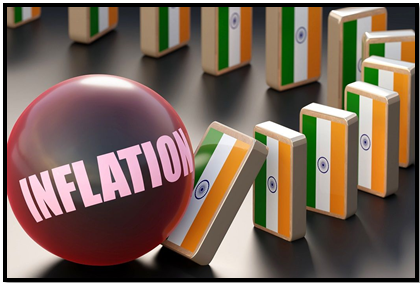RETHINKING INFLATION CONTROL IN INDIA
Syllabus:
- GS-3– Inflation in India , WPI , CPI , control of inflation , RBI’s role ,economic development
Focus :
- The article examines India’s persistent inflation problem, emphasizing the critical role of food prices in overall inflation. It critiques the suggestion to exclude food prices from the RBI’s inflation target, arguing that such a move would neglect the inflationary pressures faced by the majority of the population and underscores the need for a comprehensive agricultural strategy.
Source-TH
Introduction
- Inflation in India: Inflation control is a critical aspect of economic policy in India, and the Reserve Bank of India (RBI) plays a central role in this through inflation targeting.
- Economic Survey’s Suggestion: The Economic Survey preceding the Union Budget suggested removing food prices from the inflation target, shifting focus from ‘headline’ to ‘core’ inflation.
Food Price and Inflation Trajectory
Historical Context of Food Price Inflation
- High Food Price Inflation: Food price inflation in India has been elevated since 2019, reaching nearly 10% year-on-year in June 2023.
- Pre-pandemic Trends: This rise predates the COVID-19 pandemic and the Ukraine war, indicating that domestic factors are driving the inflation.
- Impact on Overall Inflation: Given the significant weight of food in the consumer price index (CPI), high food inflation has led to overall inflation being higher than usual.
Comparison with Global Inflation Trends
- Global Perspective: Other economies like the UK and the US have also faced inflation issues, driven largely by fluctuations in global food prices.
- Challenges in Inflation Targeting: Despite their efforts, central banks in these countries have struggled to meet their inflation targets, indicating the complex nature of inflation control.
The RBI’s Role in Inflation Control
Inflation Targeting in India
- Policy Since 2016: Inflation control has been the responsibility of the RBI since 2016, with the goal of maintaining inflation at around 4%.
- Performance: The RBI has missed this target every year for the past five years, suggesting challenges in using interest rate adjustments alone to control inflation.
Consumer Price Index (CPI)
Wholesale Price Index (WPI)
|
Critique of the Core Inflation Targeting Proposal
- Justification for Core Inflation Targeting: The suggestion to exclude food prices from the inflation target is based on the assumption that food price fluctuations are transitory.
- Challenges in Core Inflation Control: However, evidence suggests that core inflation in India is also influenced by food prices, making it unlikely that the RBI would be more successful in controlling core inflation.
The Role of Food Prices in Inflation
Food Prices as a Key Determinant
- Impact on Wages: Food prices directly influence wages, which are a significant component of core inflation.
- Interconnection with Core Inflation: This relationship undermines the effectiveness of targeting core inflation without addressing food prices.
Household Vulnerability to Food Price Inflation
- High Food Expenditure Share: In India, food accounts for nearly 50% of household expenditure, much higher than in developed economies like the US.
- Poverty and Standard of Living: A high share of food in expenditure is a proxy for poverty, making households vulnerable to food price inflation.
The Flaws in Excluding Food Prices from Inflation Targeting
Persistent Food Price Inflation
- Non-Transitory Nature: Contrary to the argument that food price spikes are transitory, India has not experienced negative food inflation in over a decade.
- Impact on Living Standards: Excluding food prices from the inflation target would ignore the most significant aspect of inflation for a large section of the population.
The Need for a Comprehensive Agricultural Strategy
- Supply-Side Measures: Addressing food price inflation requires a comprehensive approach to increasing agricultural productivity and controlling costs.
- Long-Term Solutions: The solution lies in boosting agricultural production to ensure a steady supply of food at affordable prices.
Conclusion
- Rejecting the Core Inflation Targeting Proposal: The proposal to exclude food prices from the inflation target is not a viable solution for India’s inflation problem.
- Focus on Agricultural Production: A comprehensive approach to agricultural production and cost control is essential to manage inflation effectively and protect the standard of living for the population.
Associated Article
https://universalinstitutions.com/inflation/
Mains UPSC Question
GS 3
Discuss the implications of excluding food prices from the Reserve Bank of India’s inflation targeting framework. Analyze whether targeting core inflation alone can effectively address India’s inflation challenges, considering the socio-economic impact of food price inflation.(250 words)




